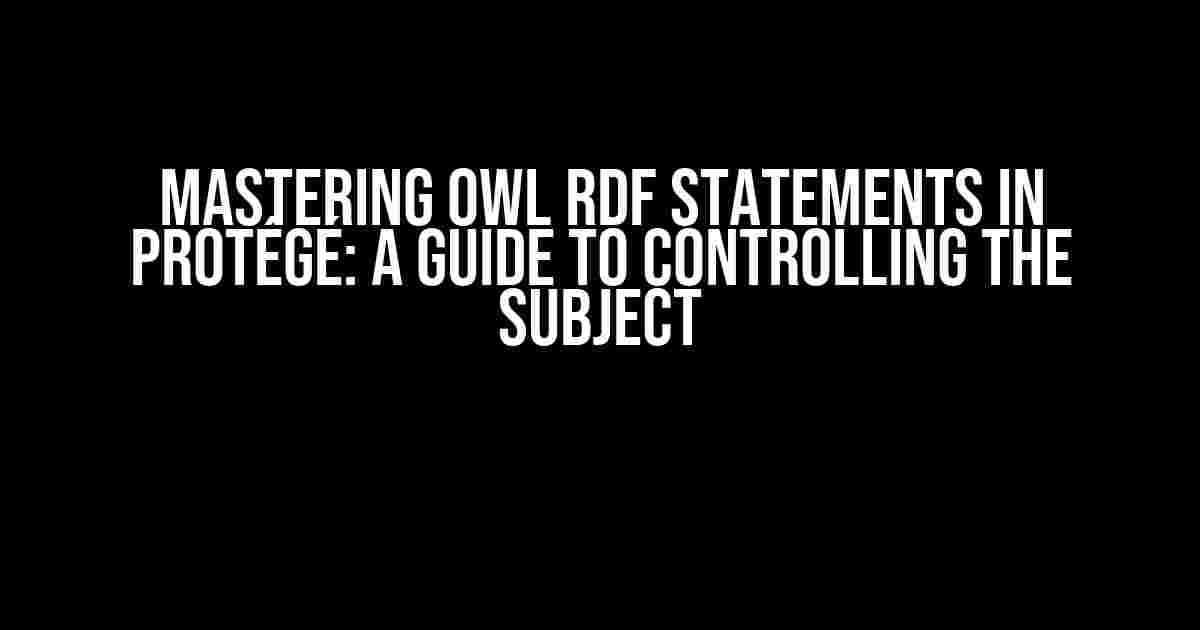Introduction
Welcome to the world of ontology development with Protégé! As you dive deeper into the realm of OWL RDF statements, you’ll soon realize that controlling the subject of these statements is crucial for creating accurate and meaningful ontologies. In this comprehensive guide, we’ll take you by the hand and walk you through the process of mastering OWL RDF statements in Protégé, with a special focus on controlling the subject.
What are OWL RDF Statements?
Before we dive into the nitty-gritty, let’s take a step back and understand the basics. OWL RDF statements are the building blocks of ontologies in Protégé. They consist of three elements: subject, predicate, and object. These statements are used to describe relationships between entities, properties, and values in your ontology.
<Subject> <Predicate> <Object>
In this example, the subject is the entity being described, the predicate is the relationship or property, and the object is the value or entity related to the subject.
The Importance of Controlling the Subject
So, why is controlling the subject of OWL RDF statements so crucial? Well, the subject is the core element that defines the focus of the statement. It’s the entity or concept being described, and getting it right is essential for creating accurate and meaningful relationships in your ontology.
- Incorrect subjects can lead to:
- Inconsistent data
- Ambiguous relationships
- Difficulty in querying and reasoning
By controlling the subject, you ensure that your statements accurately reflect the relationships and concepts in your ontology, making it easier to work with and derive insights from your data.
Step-by-Step Guide to Controlling the Subject in Protégé
Step 1: Create a New Ontology
Open Protégé and create a new ontology by going to File > New > Ontology. Choose a name for your ontology, and select the desired namespace and prefixes.
| Ontology Name | Namespace | Prefix |
|---|---|---|
| MyOntology | http://example.org/myontology# | mio |
Step 2: Create Classes and Individuals
Create classes and individuals that will serve as the subjects of your OWL RDF statements. To do this, go to the Classes tab and click the New Class button.
<mio:Car>
Repeat this process to create multiple classes and individuals. For example:
<mio:Vehicle> <mio:Toyota> <mio:Honda>
Step 3: Create Properties
Create properties that will serve as the predicates of your OWL RDF statements. To do this, go to the Properties tab and click the New Property button.
<mio:hasModel> <mio:hasYear>
Step 4: Create OWL RDF Statements
Create OWL RDF statements by selecting the subject, predicate, and object from the classes, individuals, and properties you created earlier. To do this, go to the Individuals tab and select an individual. Then, click the New Statement button.
<mio:Toyota> <mio:hasModel> <mio:Corolla>
Repeat this process to create multiple statements, controlling the subject by selecting the appropriate individual or class.
Step 5: Use Reasoning and Querying
Once you’ve created your OWL RDF statements, use Protégé’s reasoning and querying capabilities to derive insights from your data. This is where the magic happens, and you’ll see the benefits of controlling the subject in your statements.
- Reasoning: Go to the
Reasonertab and select a reasoner. This will infer new statements and relationships based on your existing data. - Querying: Go to the
Querytab and write a SPARQL query to retrieve specific data from your ontology.
Best Practices for Controlling the Subject
- Use unique and descriptive URIs for your classes, individuals, and properties.
- Use consistent naming conventions throughout your ontology.
- Avoid using ambiguous or vague terms as subjects.
- Use ontological hierarchies to organize your classes and individuals.
- Regularly review and refine your ontology to ensure accuracy and consistency.
Conclusion
Mastering OWL RDF statements in Protégé requires a deep understanding of the subject, predicate, and object. By controlling the subject, you ensure that your statements accurately reflect the relationships and concepts in your ontology. Follow the steps and best practices outlined in this guide to create robust and meaningful ontologies that drive insights and innovation.
Happy ontology development!
Here are 5 questions and answers about controlling the subject of OWL RDF statements in Protégé:
Frequently Asked Questions
Get answers to your pressing questions about controlling the subject of OWL RDF statements in Protégé!
What is the purpose of controlling the subject of OWL RDF statements in Protégé?
Controlling the subject of OWL RDF statements in Protégé is crucial to maintain data consistency and avoid ambiguity in your ontology. By specifying the subject, you can ensure that your RDF statements are well-formed and accurately represent the relationships between entities in your domain.
How do I specify the subject of an OWL RDF statement in Protégé?
To specify the subject of an OWL RDF statement in Protégé, simply select the entity you want to be the subject from the “Entity” dropdown menu in the “Create axiom” pane. You can also use the “Subject” field to enter a custom URI or QName for the subject.
Can I use variables as subjects in OWL RDF statements in Protégé?
Yes, you can use variables as subjects in OWL RDF statements in Protégé. To do this, select “Variable” as the entity type in the “Create axiom” pane and enter the variable name. This is useful when you want to create axioms that are flexible and can be instantiated with different values.
How do I control the subject of OWL RDF statements when importing ontologies in Protégé?
When importing ontologies in Protégé, you can control the subject of OWL RDF statements by specifying the import prefix and namespace. This allows you to map the imported ontology’s entities to your local ontology’s entities, ensuring consistency and accuracy.
What are the benefits of controlling the subject of OWL RDF statements in Protégé?
Controlling the subject of OWL RDF statements in Protégé provides several benefits, including improved data quality, reduced ambiguity, and increased reasoning performance. By specifying the subject, you can ensure that your ontology is well-formed, consistent, and accurately represents your domain knowledge.
